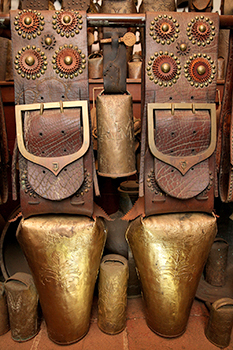 |
From 1750/60 on a group of families started to dedicate themselves to this industrial activity, and at the end of that century there are references to about 20 chocalheiros (CowBell Makers), becoming Alcáçovas the biggest centre of chocalho makers in Portugal and one of the biggest in Europe.
The origin of this industry in Alcáçovas is not yet clear, but it could be related to the coming of sheep of the merino race, around 1750, to Montemor-o-Novo.
Over the following centuries, and until the II World War, this fire art continued asserting itself, starting after this period a long and slow decay. Today only two families still fabricate them: the Maias and the Sim Sim. The firsts are seeking a demi-industrialization and the seconds struggle with a difficult continuity.
This art, which exists in other countries, particularly in Spain, France, Italy, Switzerland and Germany, has in Portugal very interesting features, due to the survival of very old making and refining techniques.
Along with the making of chocalhos, around 1900, a Sim Sim cowbell maker, António Carvalho (1897-1968), began the activity of “esquilaneiro”, i.e., the casting of esquilas (small chocalhos) and other objects associated with the production and management of animals. A change that seems to go along with a national and international tendency, as this phenomenon appears at the same time in Reguengos de Monsaraz and in France.
For several reasons these two arts are nowadays in extinction. In Portugal only in eight (?) places are chocalhos still fabricated, and in much less are esquilas being casted.
In Alcáçovas, where dozens of workshops came to work simultaneously, today only two are still working and a third one opens regularly, but without production.
Of the about twelve Portuguese cowbell makers only half should know how to produce any kind of “chocalho” and refine it.
On 1st December 2015 the Chocalho Making in Portugal was registered by UNESCO in the List of Intangible Cultural Heritage in Need of Urgent Safeguarding. This petition of register, as a pursuit of safeguarding this heritage asset from extinction, had as sponsor the Turismo do Alentejo, ERT, in protocol with the Parish Council of Alcáçovas and the City Council of Viana do Alentejo.
* “Chocalho”, in Portugal, is a sort of rattle used in the necks of cows or other animals, so that the herdsmen can keep track of their whereabouts.
1 - “Chocalho” makers.
2 -Small “chocalhos”.

 Abrir Lista
Abrir Lista MUNICÍPIO DE VIANA DO ALENTEJO
MUNICÍPIO DE VIANA DO ALENTEJO